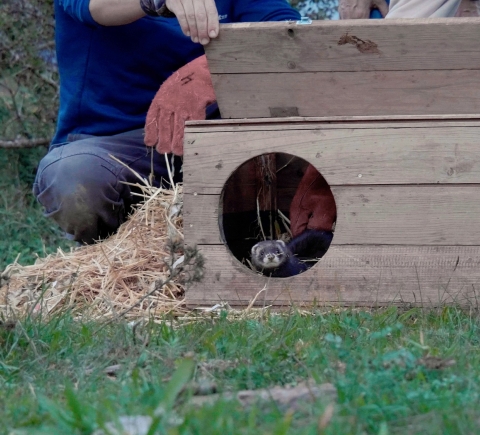


A pilot project for the captive breeding and reintroduction of polecats has been launched as part of the TuroCat project, which aims to help polecat populations in Catalonia to recover. The Barcelona Zoo Foundation is also involved.
The aim of the pilot project is to establish the extent to which polecats born in captivity can adapt to the few areas in which the species still survives and whether it could be reintroduced to other areas from which it has all but disappeared in the future
Within the framework of the TuroCat project for the recovery of the European polecat in Catalonia, on which the Department of Climate Action, Food and Rural Agenda, the Barcelona Zoo Foundation and the Trenca Foundation are collaborating, a pilot scheme to reintroduce the species has begun in the Lleida area, involving the release of individuals from the captive breeding programme initiated as part of the project, with the support of the DACC's El Pont de Suert Wildlife Centre. The project has also enjoyed the support of a private zoo in the Pallars Sobirà region. This is the first-ever release of captive-bred European polecats (Mustela putorius) into the wild.
The initiative is being carried out in partnership with Raimat Natura, where seven individuals were released today. This is a natural area spanning 700 hectares in which hundreds of water birds, endangered birds of prey, mammals and the Raimat winery's organic vineyards all coexist in complete harmony. The space has been open to the public free of charge since May 2021, to enable everyone to discover its rich biodiversity.
Polecats are highly skilled at hunting rabbits, which pose a serious problem for agriculture precisely in the Lleida area. The pilot project will also assess the extent to which specimens born in captivity are able to adapt, by observing how they interact with the rabbits that are the dominant species in this area. However, amphibians, rats and other rodents are also found here.
A further six individuals have been released in the Alt Empordà region, where the largest populations of this endangered species are to be found. The animals that have been released have been fitted with trackers so that they can be monitored, and their adaptation to the environment studied.
This pilot scheme is part of a wider initiative to build up a breeding stock and to breed this endangered species in captivity so that the animals can subsequently be released into the wild. Work to obtain wild specimens and move them to other parts of Catalonia where there needs to be a focus on the recovery of populations is also under way.
This pioneering wildlife breeding and reintroduction project will continue over the next few years with a view to increasing the size of polecat populations in other areas identified by the scientists taking part in the TuroCat project as a result of ongoing monitoring to assess how the species is doing. Reconnecting polecat populations to each other and preventing genetic isolation is key to the future of the species in Catalonia. In addition, partnerships with primary-sector companies and organisations and owners of land that has high ecological value for these animals will also be strengthened.
An endangered species
European polecats are included as an endangered species on the list of wildlife under threat in Catalonia which was approved by the Generalitat de Catalunya in October. In fact, it is one of our most endangered mammals. Over the last 30 years, areas of distribution have been drastically reduced and numbers have plummeted to their current levels, with populations living only on some parts of the plains of the Alt and Baix Empordà regions, and individuals being occasionally spotted at the source of the river Ter, in the Ripollès.
The TuroCat project was created in 2018 thanks to the support provided by the Generalitat de Catalunya, and a grant awarded by the Barcelona Zoo Foundation.

